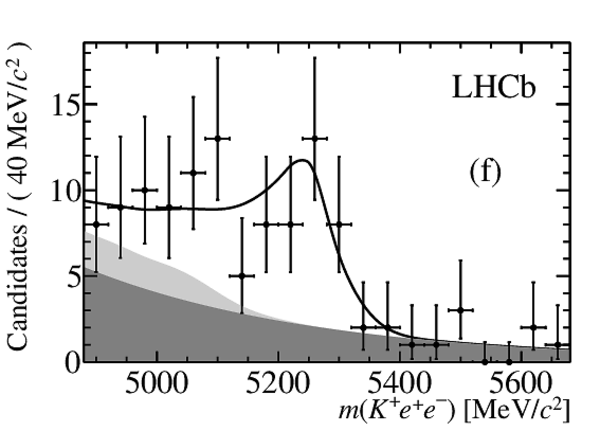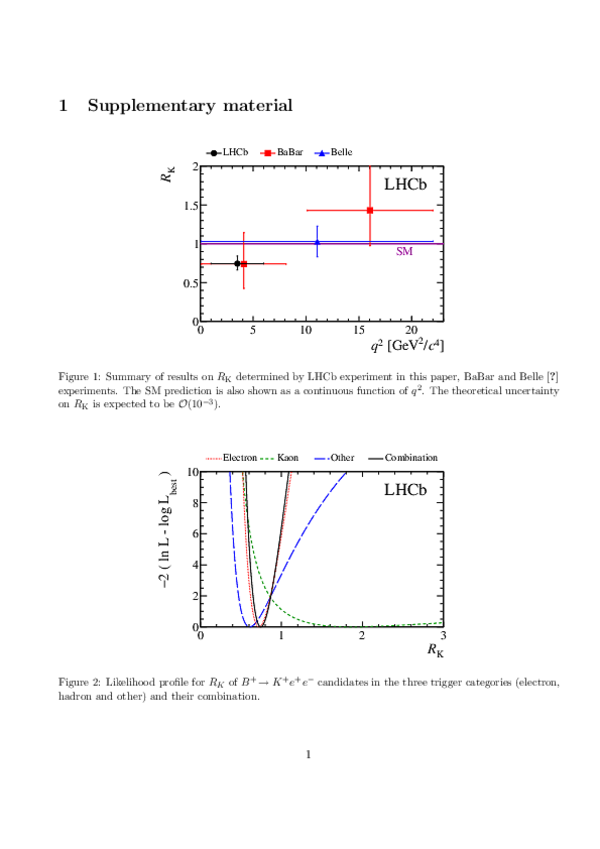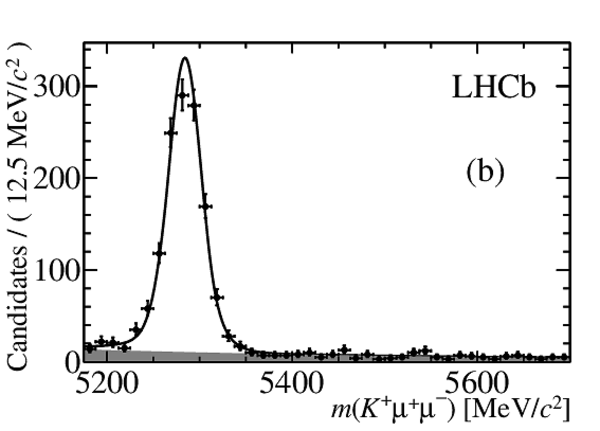Test of lepton universality using $B^{+}\rightarrow K^{+}\ell^{+}\ell^{-}$ decays
[to restricted-access page]Information
LHCb-PAPER-2014-024
CERN-PH-EP-2014-140
arXiv:1406.6482 [PDF]
(Submitted on 25 Jun 2014)
Phys. Rev. Lett. 113 (2014) 151601
Inspire 1303108
Tools
Abstract
A measurement of the ratio of the branching fractions of the $B^{+}\rightarrow K^{+}\mu^{+}\mu^{-}$ and $B^{+}\rightarrow K^{+}e^{+}e^{-}$ decays is presented using proton-proton collision data, corresponding to an integrated luminosity of 3.0 fb$^{-1}$, recorded with the LHCb experiment at center-of-mass energies of 7 and 8 $\mathrm{ Te V}$. The value of the ratio of branching fractions for the dilepton invariant mass squared range $1<q^{2}<6\mathrm{ Ge V^2 /}c^4$ is measured to be $0.745^{+0.090}_{-0.074}\mathrm{ (stat)} \pm0.036\mathrm{ (syst)}$. This value is the most precise measurement of the ratio of branching fractions to date and is compatible with the SM prediction within $2.6$ standard deviations.
Figures and captions
|
Dilepton invariant mass squared, $ q^2$ , as a function of the $ K ^+ \ell^+ \ell^- $ invariant mass, $m( K ^+ \ell^+ \ell^- )$, for selected (a) $ B ^+ \rightarrow K ^+ \mu ^+\mu ^- $ and (b) $ B ^+ \rightarrow K ^+ e ^+ e ^- $ candidates. The radiative tail of the $ { J \mskip -3mu/\mskip -2mu\psi \mskip 2mu}$ and $\psi {(2S)}$ mesons is most pronounced in the electron mode due to the larger bremsstrahlung and because the energy resolution of the ECAL is lower compared to the momentum resolution of the tracking system. |
Fig1a.pdf [65 KiB] HiDef png [1 MiB] Thumbnail [651 KiB] *.C file |

|
|
Fig1b.pdf [53 KiB] HiDef png [1 MiB] Thumbnail [514 KiB] *.C file |

|
|
|
Mass distributions with fit projections overlaid of selected $ B ^+ \rightarrow { J \mskip -3mu/\mskip -2mu\psi \mskip 2mu} (\rightarrow e ^+ e ^- ) K ^+ $ candidates triggered in the hardware trigger by (a) one of the two electrons, (b) by the $ K ^+$ and (c) by other particles in the event. Mass distributions with fit projections overlaid of selected $ B ^+ \rightarrow K ^+ e ^+ e ^- $ candidates in the same categories, triggered by (d) one of the two electrons, (e) the $ K ^+$ and (f) by other particles in the event. The total fit model is shown in black, the combinatorial background component is indicated by the dark shaded region and the background from partially reconstructed $ b $ -hadron decays by the light shaded region. |
Fig2a.pdf [17 KiB] HiDef png [113 KiB] Thumbnail [62 KiB] *.C file |

|
|
Fig2b.pdf [17 KiB] HiDef png [122 KiB] Thumbnail [66 KiB] *.C file |

|
|
|
Fig2c.pdf [17 KiB] HiDef png [117 KiB] Thumbnail [64 KiB] *.C file |

|
|
|
Fig2d.pdf [17 KiB] HiDef png [137 KiB] Thumbnail [76 KiB] *.C file |

|
|
|
Fig2e.pdf [17 KiB] HiDef png [133 KiB] Thumbnail [76 KiB] *.C file |

|
|
|
Fig2f.pdf [17 KiB] HiDef png [131 KiB] Thumbnail [72 KiB] *.C file |

|
|
|
Animated gif made out of all figures. |
PAPER-2014-024.gif Thumbnail |

|
Supplementary Material [file]
Created on 27 April 2024.





